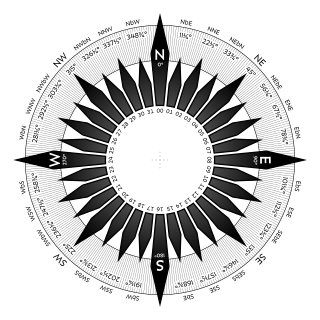Points of the compass
Either form is easily understood, but alternative conventions as to correct usage developed in different countries and organisations."[8] Compass roses very rarely named the fractional points and only showed small, unlabelled markers as a guide for helmsmen.[10] This exercise became more significant as navigation improved and the half- and quarter-point system increased the number of directions to include in the 'boxing'.The traditional mariner's wind names were expressed in Italian, or more precisely, the Italianate Mediterranean lingua franca common among sailors in the 13th and 14th centuries, which was principally composed of Genoese (Ligurian), mixed with Venetian, Sicilian, Provençal, Catalan, Greek, and Arabic terms from around the Mediterranean basin.The traditional names of the eight principal winds are: Local spelling variations are far more numerous than listed, e.g. Tramutana, Gregale, Grecho, Sirocco, Xaloc, Lebeg, Libezo, Leveche, Mezzodi, Migjorn, Magistro, Mestre, etc.Navigation texts dating from the Yuan, Ming, and Qing dynasties in China use a 24-pointed compass with named directions.






compass roseradiallynavigationcartographycardinal directionsdegreesmeteorologycolloquialNortheast (disambiguation)Northwest (disambiguation)Southeast (disambiguation)Southwest (disambiguation)compound wordsstyle guidesset unionmnemoniccompassclockwisecounterclockwiseUnited States NavyRoyal NavyMediterranean SeaMiddle Agesclassical compass windsItalianMediterranean lingua francaLigurianVenetianSicilianProvençalCatalanArabicpatoisportolan chartsazimuthTramontanaLevanteSciroccoLibeccioPonenteMaestroEarthly BranchesBearing (navigation)Cardinal directionCourse (navigation)Heading (navigation)Wind roseEvans, Frederick JohnGraphicacyWiktionaryDotdashUniversity of WashingtonCardinalordinalTramontaneGregaleLevantSiroccoMistral